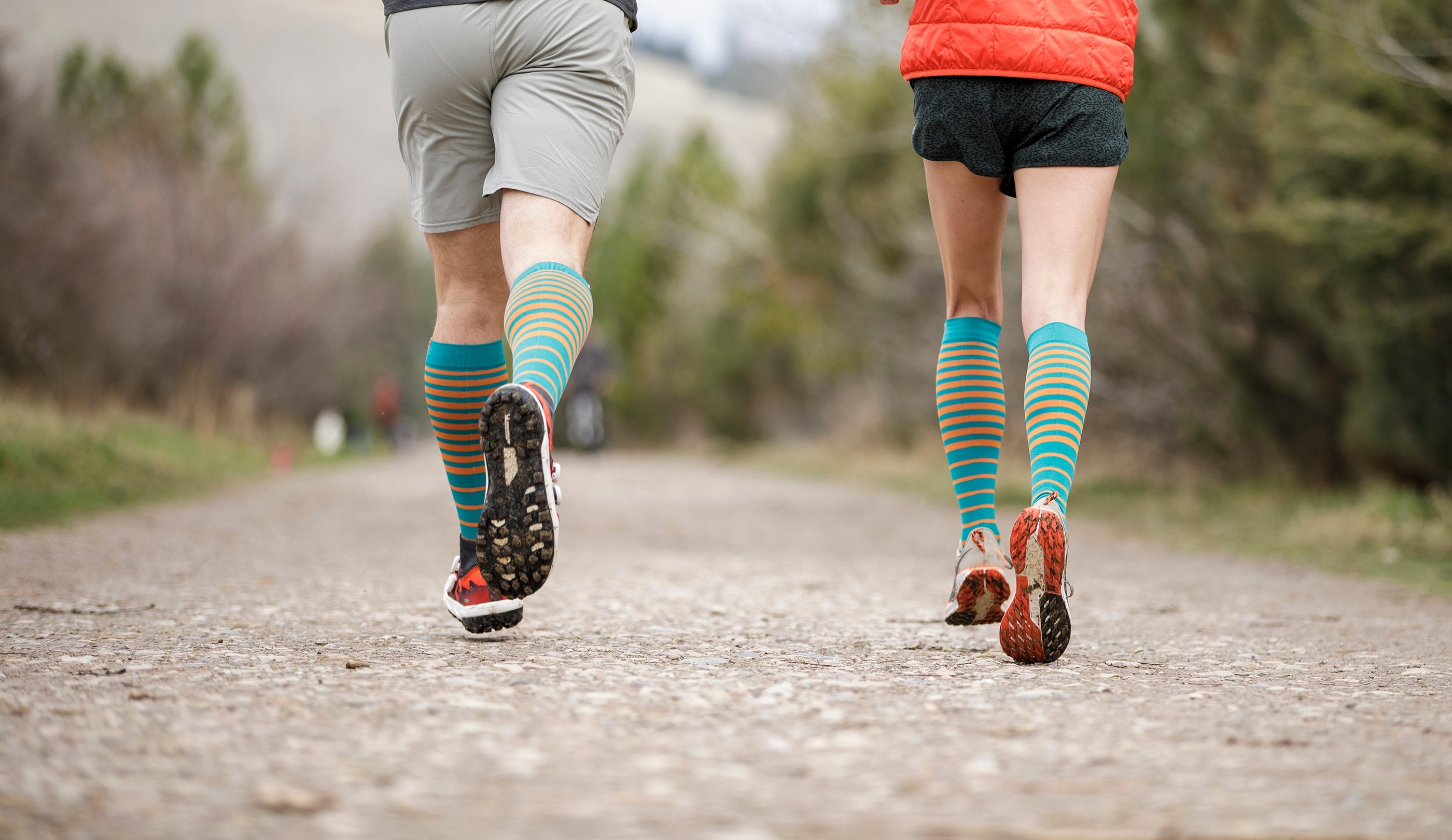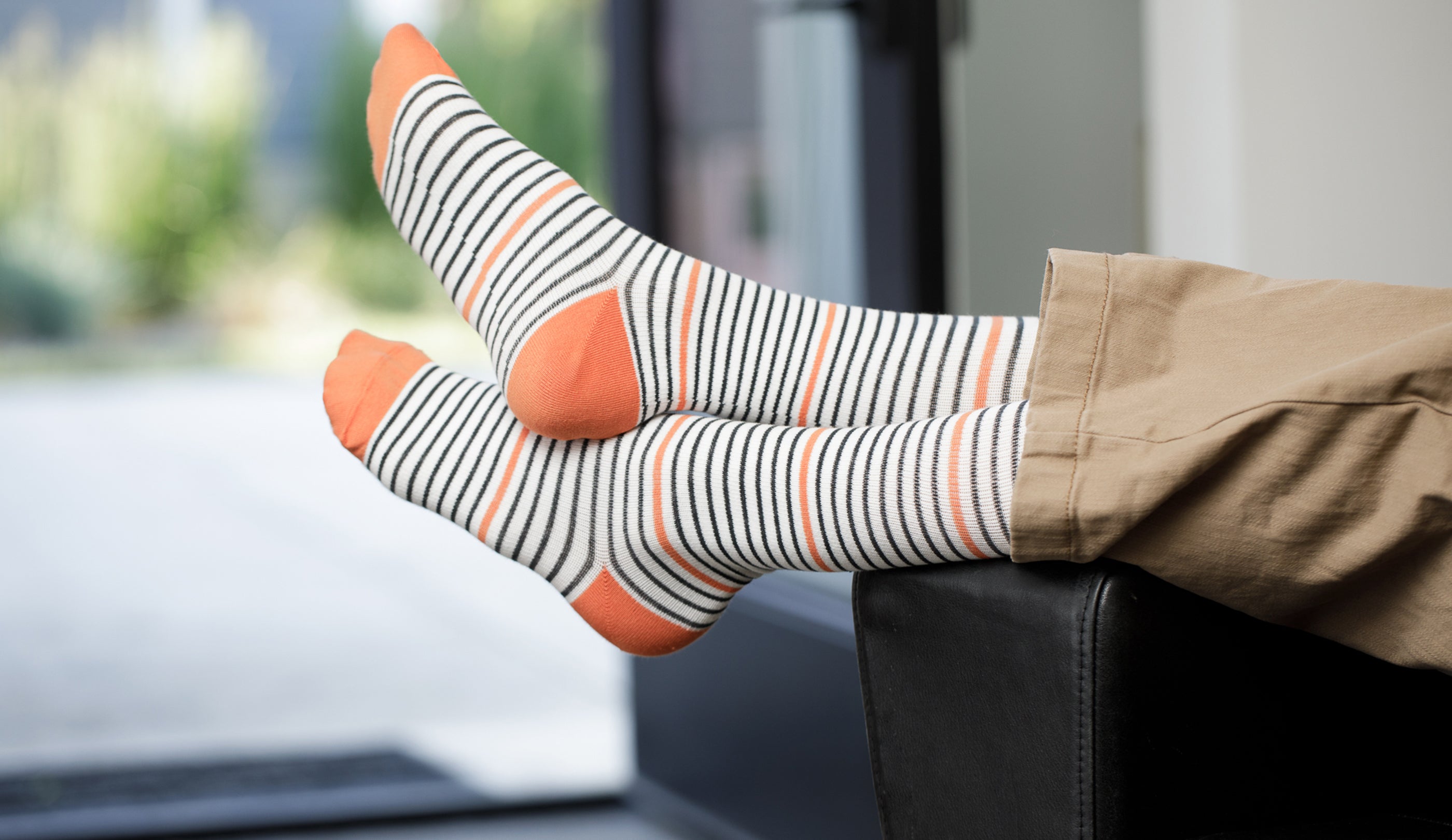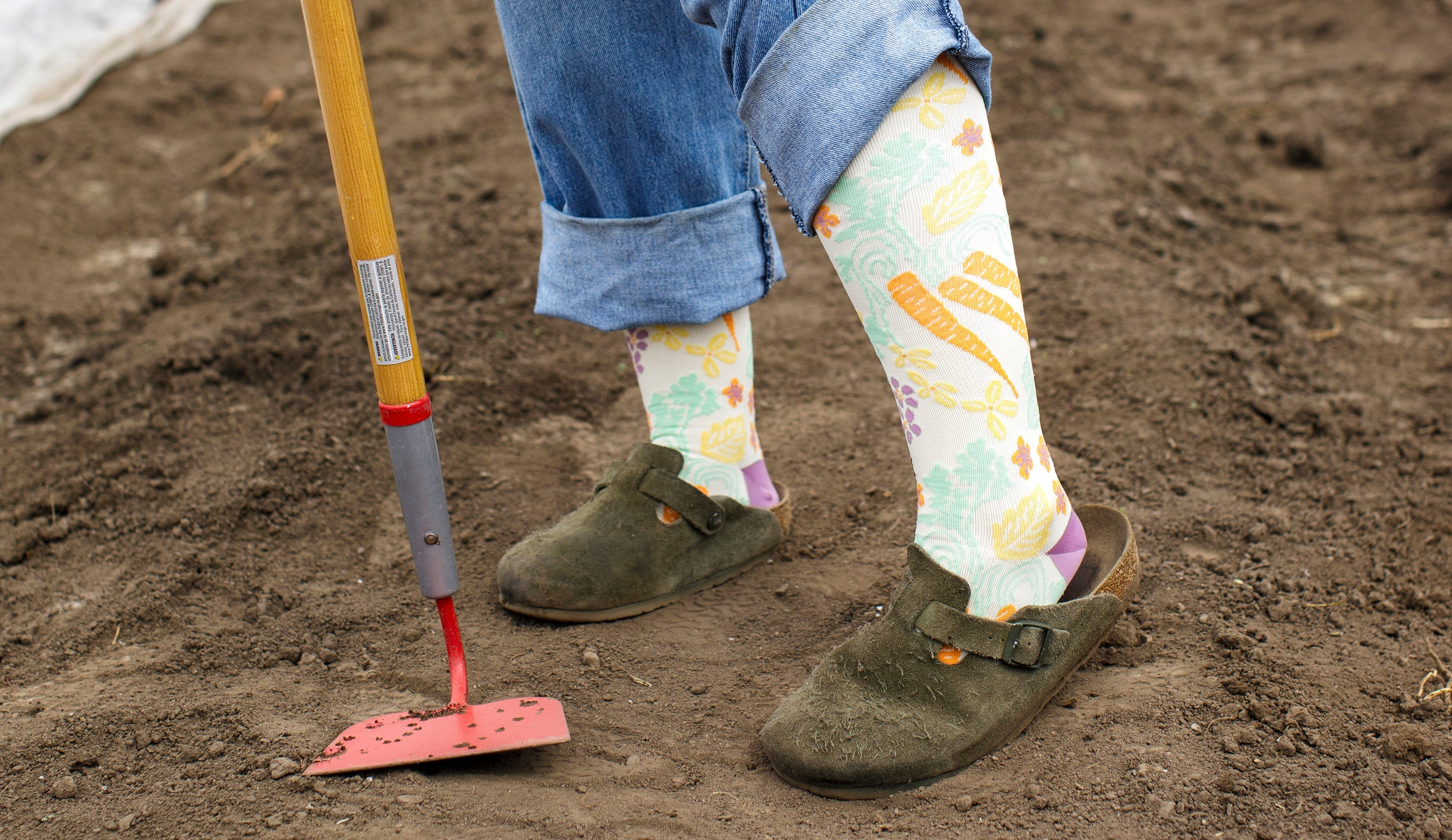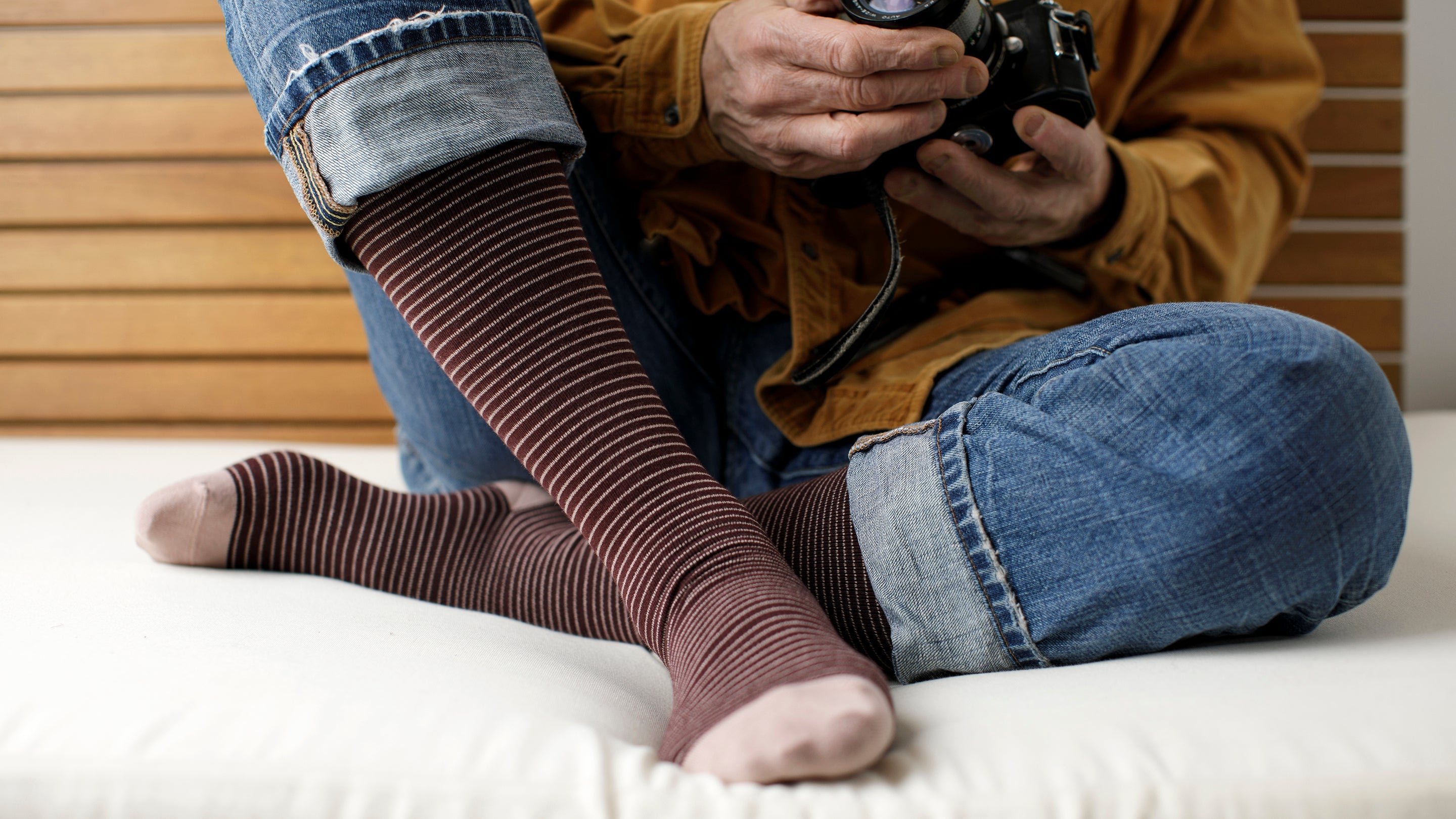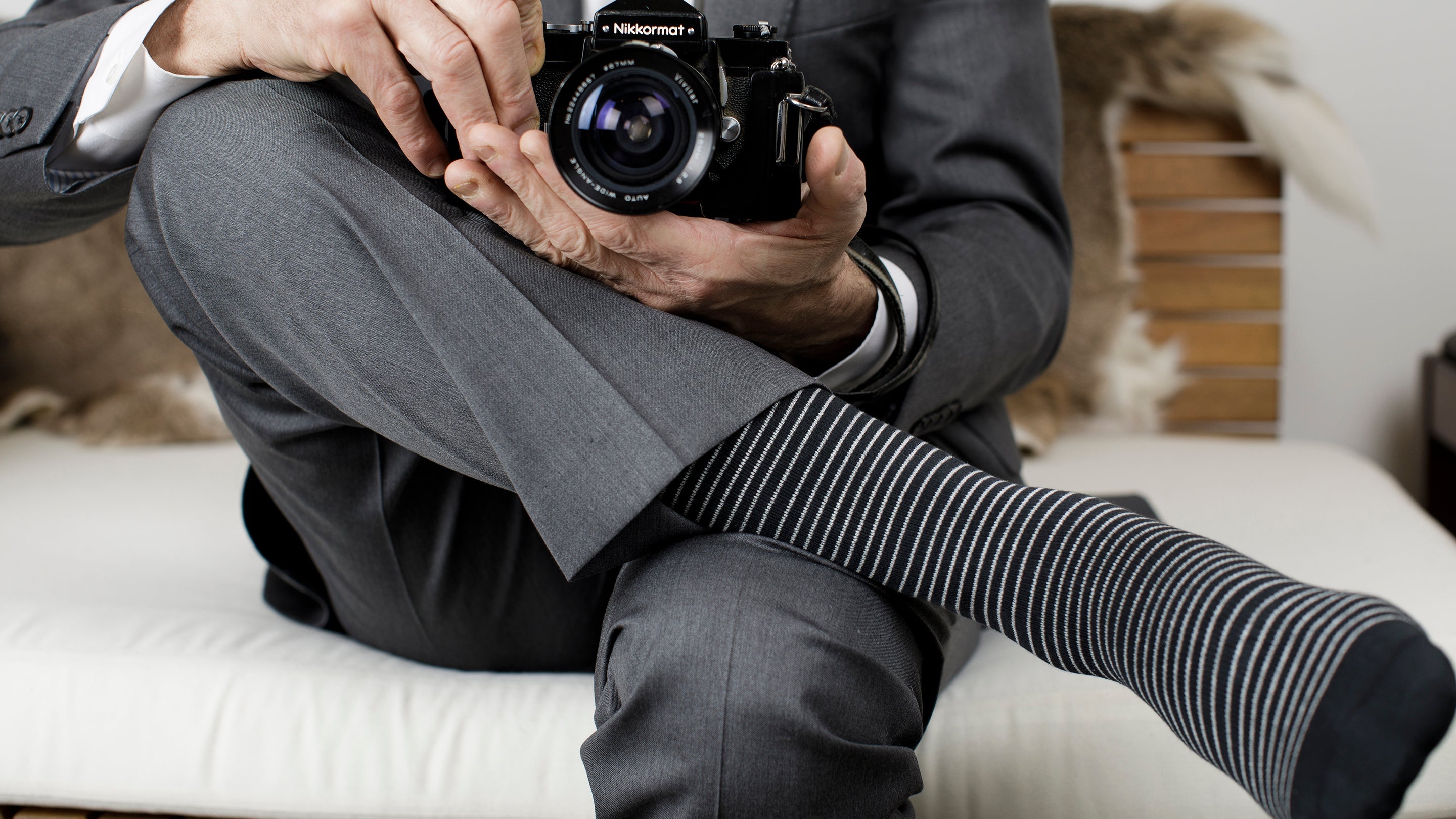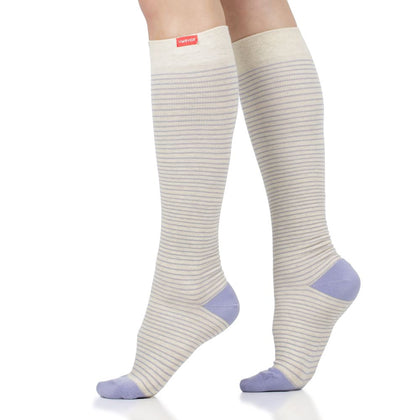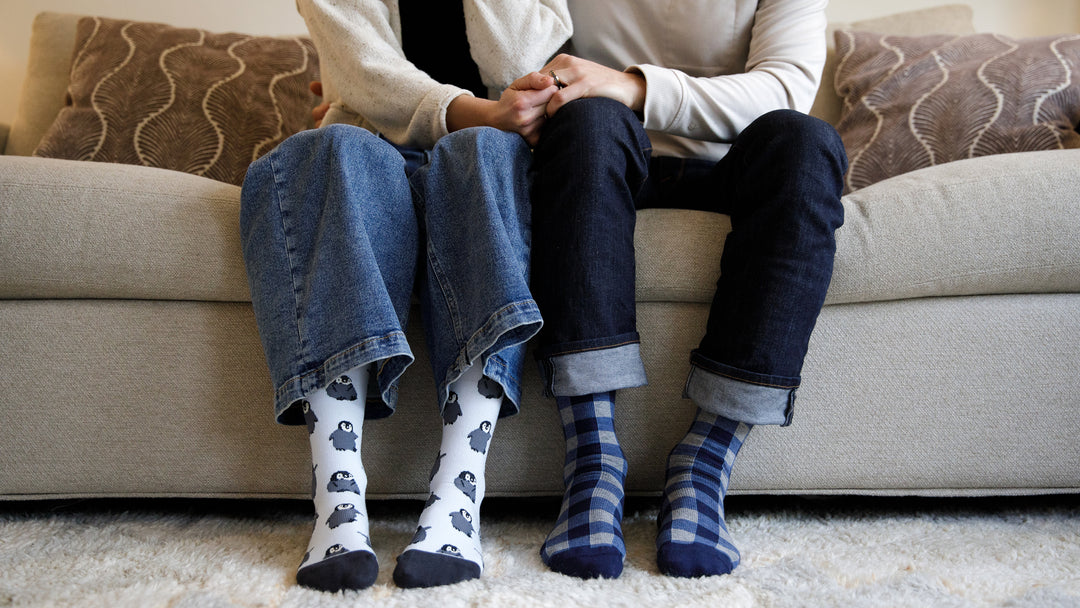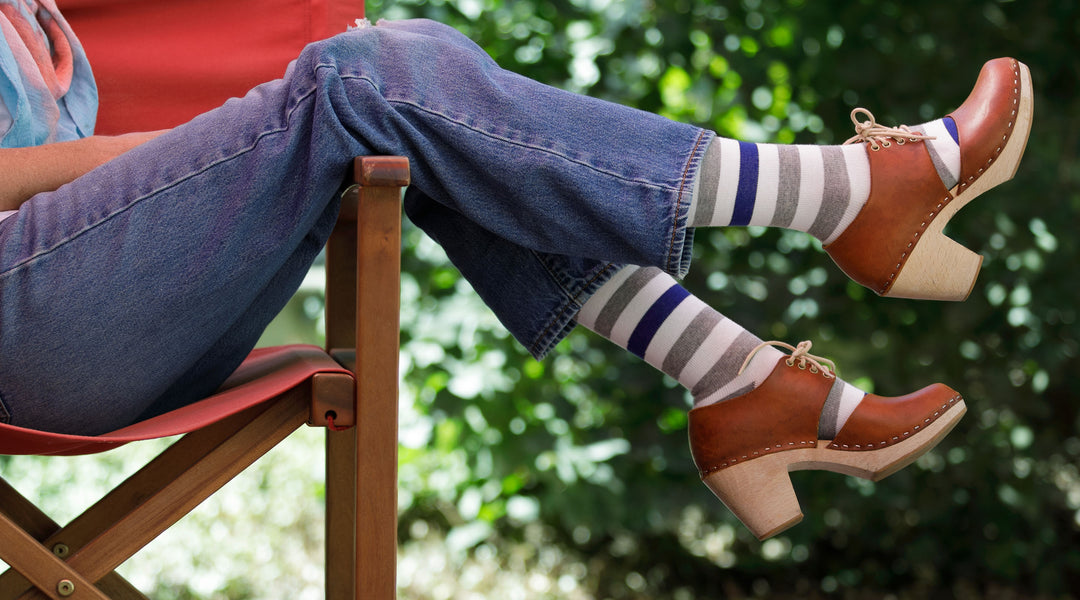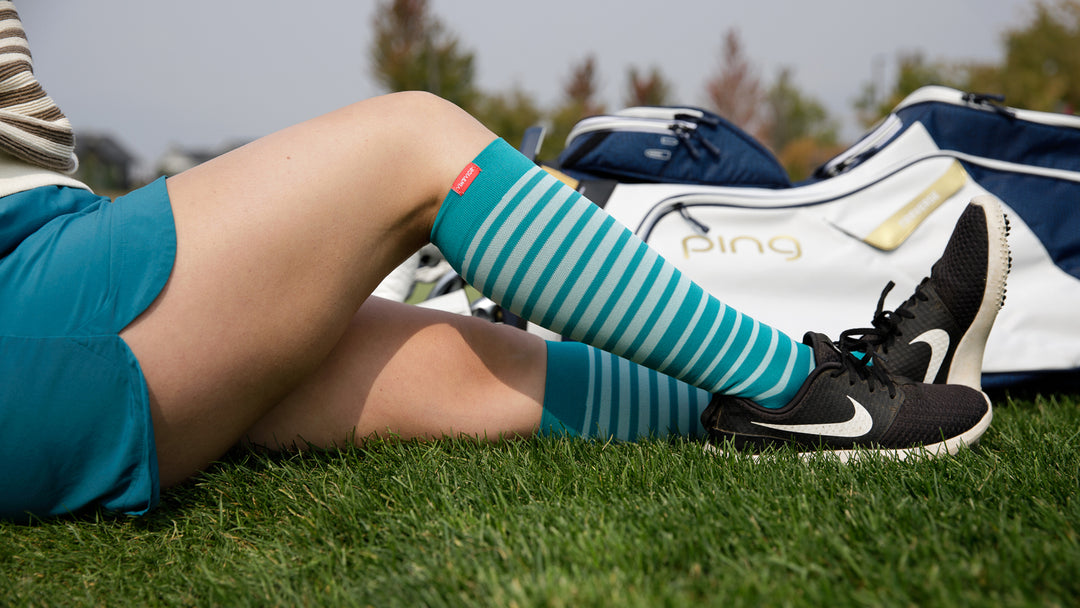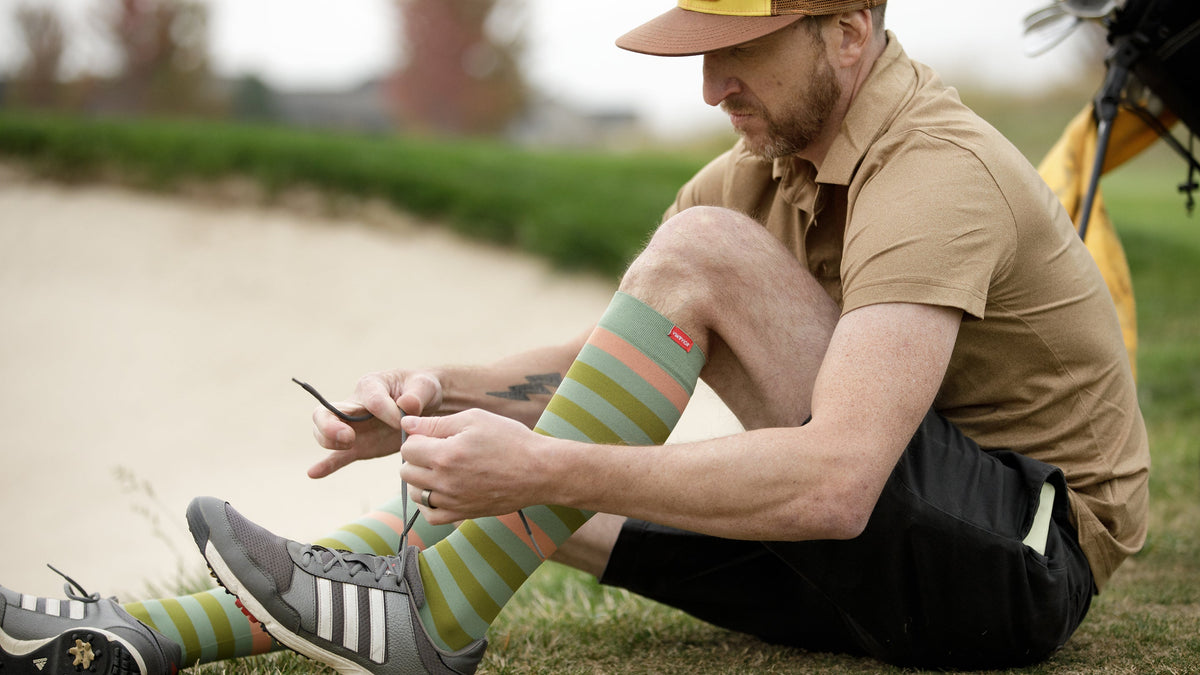

Compression socks are an essential part of a preventative care toolkit for leg health, and they can help you feel your best day in and day out. Compression socks can be used in many ways to provide health benefits or help you recover from injury or even exercise. They are commonly used to relieve swelling and discomfort. They are especially beneficial when you are traveling, sitting at your desk, or standing around for long periods of time. Compression socks play a key role in improving circulation in the lower limbs, reducing the risk of blood clots, deep vein thrombosis, and other complications. Also, they’re used regularly by professional and recreational athletes to reduce feelings of fatigue and improve performance or to boost their recovery and reduce soreness.
Despite their clear benefits, it is not always obvious when you should wear compression socks for the best results. This depends on the activity you’re planning to do, your medical condition, and some other external factors (e.g., the weather). But, if you’ve been wondering, “when should I wear my compression socks?” - we have a series of scenario specific answers for you in this article.

When Should I Wear My Compression Socks?
Graduated compression socks help boost peripheral circulation and improve lymphatic drainage, according to scientific research. This means that compression socks reduce the risk of swelling and discomfort, which often happens when you sit or stand for long periods of time. There are also benefits from wearing compression before, during, or after workouts, during pregnancy, as you recover from surgery, or in many other situations.
When You Sit for Long Periods
When you sit behind a desk for hours at a time, gravity pushes down and impedes upward blood flow. This is what can cause swollen feet and ankles, as the blood pools in the lower limbs, which is proven to cause pain and discomfort. So, if you have a regular desk job, you are at a high risk of developing leg health problems. In a 2017 study, nearly 42% of people that worked an 8-hour day at a desk had pain or discomfort in feet or legs.
So, should you wear compression socks if you sit for long periods of time?
Graduated compression socks are tighter at the ankles and release the pressure as they climb up towards the knees. This stimulates venous return, which is scientifically proven to reduce swelling or the risk of blood clots and other complications. Compression garments are often recommended by doctors to avoid edema, but they can also help after the extended sitting, by reducing swelling by at least 33% and up to 100%. Wearing compression socks for plane rides of 4 or more hours is highly recommended. A 2021 medical report found that compression socks reduce the risk of deep vein thrombosis (aka blood clots) by 10 to 45%.
So, you can either wear your socks for the entire time you’ll be sitting at work or on a long plane ride, or if you’ve forgotten, you can put them on as soon as you get home to feel how they soothe and relax the muscles to reduce swelling. For even better results, elevate your legs to further boost blood flow and take the pressure off your lower limbs.
When You Stand All Day
Because of gravitational pressure, standing can cause as much pain or discomfort in the legs as sitting due to poor blood flow. Many professions require people to stand for hours on end (teachers, hairdressers, nurses), very often walking on hard ground, which also has an impact on the joints and muscles (construction workers, for example). A pair of high-quality compression socks not only ensures that lower leg circulation continues throughout shifts, but also supports the veins, the muscles, and the joints.
Compression socks can reduce the risk of developing varicose veins or deep vein thrombosis while standing for long periods of time. Additionally, they take pressure off the veins, reducing the likelihood of fluid seeping into tissues (leading to poor lymphatic drainage) and the incidence of swelling and discomfort (studies show their positive role in preventing occupational edema – which is swelling caused by work conditions). Through the tight grip compression socks have on the muscles and joints, they also reduce some of the impact of walking or standing on hard surfaces.
One review article found that compression garments can stabilize your muscles, which can limit the impacts of repeated landing on hard surfaces. This was found to reduce fatigue and soreness when you stand all day.

When Exercising or Recovering from a Workout
Thanks to both the way they improve blood flow and the support they offer to joints and muscles, compression socks are a favorite supportive clothing item for all athletes. When you exercise, you put varying levels of pressure on your muscles and blood vessels due to jumping or running, hitting hard surfaces, or experiencing muscle damage through your workout.
A 2015 study found that over 3-weeks of compression sock use during running, compression socks reduce the level of impact experienced when you land and take off again. Moreover, compression socks support blood flow in the lower limbs, which maintains muscle oxygenation during runs, which has been discovered to delay feelings of fatigue and muscle soreness. Finally, compression socks reduce the micro vibrations on our joints and muscles, particularly when you land on hard surfaces when doing a road run or playing tennis or basketball.
This evidence shows that you should wear compression socks when you exercise to increase comfort, reduce the likelihood of injury or soreness, and improve endurance. Research from 2021 shows that wearing compression socks after a workout, to speed up the recovery process by reducing soreness and swelling or inflammation (by 35 to 40% after 24 hours and up to 60% after 48 hours).
When Pregnant or Managing Fluid Retention
During pregnancy, blood volume can increase by up to 50%. This places a huge amount of pressure on the circulatory system. This can also lead to fluid retention, which causes swelling and discomfort. Approximately 80% of pregnant women experience edema, which is clinically problematic swelling. Luckily, wearing compression socks is a clinically effective and easy way to combat pregnancy edema, fluid retention, and venous insufficiency.
Graduated compression socks stimulate upward blood flow, which prevents blood from pooling in the lower leg veins or to fluid leaking into the tissues (which increases the risk of blood clots, fluid retention, edema, and varicose veins). Compression socks also apply a soothing massage to the lower leg muscles, which may reduce cramps or symptoms of restless leg syndrome and may even improve sleep quality during pregnancy.
When Recovering from Surgery
Medical reports suggest that wearing compression stockings or socks after surgery helps reduce the swelling in the feet, calves, ankles, and thighs. When you’re immobile for longer stretches of time, your risk of developing blood clots or deep vein thrombosis increases. Luckily, wearing medical-grade compression socks is an effective way to reduce it.
Depending on the type of surgery you’ve had, doctors usually prescribe compression socks for around 4 to 6 weeks after major interventions and 1 to 2 weeks for minor ones. It depends on your personal circumstances and risk factors, so consult with your doctor to get the best advice. You can learn more about wearing compression socks after surgery here.

When You Have Certain Medical Conditions
Many people can benefit from wearing compression socks to improve circulation, reduce swelling, and revitalize their lower limbs, especially if they suffer from common chronic medical conditions. For certain medical conditions, compression socks are an effective tool for easing symptoms and improving overall wellbeing. These include:
- Chronic venous insufficiency
- Varicose veins
- Leg edema
- Populations at risk of edema (e.g. obese, pregnant, previously suffered from blood clots, or bedridden patients)
Anytime You Want to Support Daily Wellness
Finally, compression socks are a stylish way to add more support to the lower limbs, improve circulation, and prevent leg health issues. They can match any outfits and are versatile enough to accompany you during workouts, travels, or moments of relaxation. Whether you’re looking to boost blood flow, relax with a soothing massage, or enjoy some additional support to the joints, you can use graduated compression in a multitude of designs, patterns, and fabrics in our Vim & Vigr collection.
When to Wear Compression Socks Each Day
Is it better to wear compression socks all day or for specific bouts? Are breaks from wearing compression socks essential? Here are some tips from doctors and medical experts.
All Day Wear vs Shorter Intervals
Compression socks are safe to wear the whole day and can even be worn to sleep in at night, according to this 2023 report. However, if you’re not familiar with this type of garment, it’s better to start by wearing compression legwear for 2-3 hours at first. Then, slowly increase the length of time you wear them, depending on your activity levels and personal preferences.
If you travel long distances, it’s perfectly safe to keep your graduated compression socks throughout the flight to prevent swelling and help keep blood flowing into the extremities. Similarly, people who struggle with restless leg syndrome or poor sleep quality can keep a pair of compression socks on overnight.
When to Take Breaks
Listen to your body and wear compression socks as long as it is comfortable and take breaks when you need to. Many people prefer to wear their compression socks for workouts or a long walk or hike, for example, and then switch to barefoot or other types of socks afterwards. Others will wear them for the length of a work shift, while others yet will only put them on when they get home and want to relax. It is up to you!
Always Follow Your Doctor’s Advice
If you have specific medical conditions or any doubts about how long to wear compression socks for, it is always best to speak to a doctor. They will advise you based on your specific case.
How to Choose the Right Compression Socks for You
Compression socks work best when they’re comfortable, yet tight enough to apply therapeutic pressure to the limbs, but loose enough to not restrict your range of motion. You also need to be aware of the different types of fabric and of how to put them on and take them off.
Understanding Compression Levels
The pressure that compression socks apply to the limbs varies, with three typical categories measured in mmHg:
- 15-20 mmHg socks are great for first-time wearers and for everyday situations such as going to work or relaxing after being on your feet all day - they are firm, but comfortable and flexible.
- 20-30 mmHg socks apply more pressure to the limbs and are recommended to those at risk of blood clots or deep vein thrombosis, patients with varicose veins, or during pregnancy.
- 30-40 mmHg socks are the strongest and can only be purchased with a doctor’s prescription - they are normally used for post-surgery or injury recovery or in the case of more serious medical conditions.
Choosing the Right Fabric
Fabric is especially important for your choice of socks because it affects comfort, breathability, and flexibility. At Vim & Vigr, we offer several types of fabric depending on your planned activity or environmental conditions:
- Cotton is great for everyday wear, stretchy and soft, but does not wick away moisture as well, so would not be your best choice for physical activity.
- Nylon is stretchy, sleek, and flexible, ideal for working out as it moves with your body, and you won’t even feel it’s there!
- Choice nylon is a special fabric we’ve created that removes the toe seam for lower risks of chafing and discomfort.
- Moisture wick nylon is made to let your feet breathe and ensure you can keep working out without the sweat.
- Merino wool is a temperature regulating, moisture wicking, hypoallergenic and antibacterial fabric that is soft and comfortable - great for keeping you cool or warm, depending on the weather!
Finding the Perfect Fit
Finally, always ensure your socks are the right size and that they fit your lower legs well enough to apply therapeutic pressure without becoming uncomfortable. We recommend measuring the circumference of your calf muscles and matching that against our sizing chart, available for each product, so you get the best fit.
Upon first putting on your compression socks, follow our guide to ensure there’s no folding or bunching and that you’ll feel as comfortable as possible.
Graduated compression socks offer a versatile, stylish, and easy solution to prevent or combat lots of sources of discomfort and potential health problems. Thanks to how they stimulate blood flow, reduce swelling and inflammation, and support the muscles and joints, they can be used when you’re setting off on a long journey, when you work out, when you’re recovering from a long day on your feet, or in lots of different situations depending on medical conditions. Take your pick from our varied models and designs and start enjoying lighter, more comfortable lower legs right away!
References
Bieuzen, F., Brisswalter, J., Easthope, C., Vercruyssen, F., Bernard, T., & Hausswirth, C. (2014). Effect of wearing compression stockings on recovery after mild exercise-induced muscle damage. International journal of sports physiology and performance, 9(2), 256–264. Read it here.
Charles, T., Mackintosh, D., Healy, B., Perrin, K., Weatherall, M., & Beasley, R. (2011). Merino wool graduated compression stocking increases lower limb venous blood flow: a randomized controlled trial. Advances in therapy, 28(3), 227–237. Read it here.
Clarke, M. J., Broderick, C., Hopewell, S., Juszczak, E., & Eisinga, A. (2021). Compression stockings for preventing deep vein thrombosis in airline passengers. The Cochrane database of systematic reviews, 4(4), CD004002. Read it here.
Jamshaid, H., Mishra, R. K., Ahmad, N., Nadeem, M., Muller, M., & Kolar, V. (2022). Exploration of Effects of Graduated Compression Stocking Structures on Performance Properties Using Principal Component Analysis: A Promising Method for Simultaneous Optimization of Properties. Polymers, 14(10), 2045. Read it here.
Lim, C. S., & Davies, A. H. (2014). Graduated compression stockings. CMAJ: Canadian Medical Association journal = journal de l'Association medicale canadienne, 186(10), E391–E398. Read it here.
Lucas-Cuevas, A. G., Priego-Quesada, J. I., Aparicio, I., Giménez, J. V., Llana-Belloch, S., & Pérez-Soriano, P. (2015). Effect of 3 Weeks Use of Compression Garments on Stride and Impact Shock during a Fatiguing Run. International journal of sports medicine, 36(10), 826–831. Read it here.
Mirakhmedova, S., Amirkhanov, A., Seliverstov, E., Efremova, O., & Zolotukhin, I. (2023). Daily Duration of Compression Treatment in Chronic Venous Disease Patients: A Systematic Review. Journal of personalized medicine, 13(9), 1316. Read it here.
Pappas, C. J., & O'Donnell, T. F., Jr (1992). Long-term results of compression treatment for lymphedema. Journal of vascular surgery, 16(4), 555–564. Read it here.
Partsch, H., Winiger, J., & Lun, B. (2004). Compression stockings reduce occupational leg swelling. Dermatologic surgery: official publication for American Society for Dermatologic Surgery [et al.], 30(5), 737–743. Read it here.
Sachdeva, A., Dalton, M., & Lees, T. (2018). Graduated compression stockings for prevention of deep vein thrombosis. The Cochrane database of systematic reviews, 11(11), CD001484. Read it here.
Saliba-Júnior, O. A., Rollo, H. A., Saliba, O., & Sobreira, M. L. (2022). Positive perception and efficacy of compression stockings for prevention of lower limb edema in pregnant women. Jornal vascular brasileiro, 21, e20210101. Read it here.
Soma-Pillay, P., Nelson-Piercy, C., Tolppanen, H., & Mebazaa, A. (2016). Physiological changes in pregnancy. Cardiovascular journal of Africa, 27(2), 89–94. Read it here.
Waters, T. R., & Dick, R. B. (2015). Evidence of health risks associated with prolonged standing at work and intervention effectiveness. Rehabilitation nursing: the official journal of the Association of Rehabilitation Nurses, 40(3), 148–165. Read it here.
